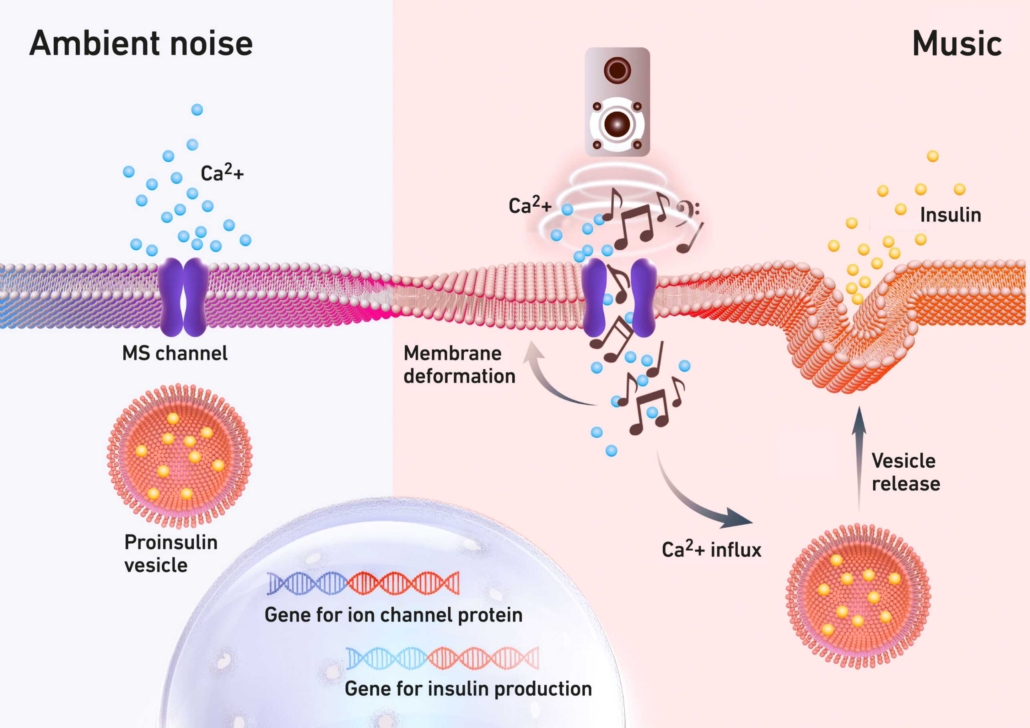
Synbio experts develop cells that hear
ETH Zurich researchers have developed a gene switch that triggers insulin release in designer cells by playing music.
Swiss researchers headed by synbio expert Martin Fussenegger have equipped designer cells with a bacterail ion channel that is responsive to mechanical stimuli such as sound waves to controll drug delivery or switch on gene circuits. Upon direct sonication at the right volume and pitch the cells were triggered to release insulin within a few minutes.
To protect insulin-?producing from attacks of the innate immune system, the researchers enclosed the cells in capsules that can be implanted in the body. To be able to control from the outside when and how much insulin the cells release into the blood, researchers have studied and applied different triggers in recent years: light, temperature and electric fields.
Fussenegger and his colleagues have now developed another, novel stimulation method: they use music to trigger the cells to release insulin within minutes. This works especially well with We Will Rock You, a hit by British rock band, Queen.
To make the insulin-?producing cells receptive to sound waves, the researchers incorporated E. coli DNA into human insulin-?producing cells encoding a Ca2+ ion channel membrane protein. They then demonstrated, that the channel in these cells opens in response to sound, allowing positively charged calcium ions to flow into the cell. This leads to a charge reversal in the cell membrane, which in turn causes the tiny insulin-?filled vesicles inside the cell to fuse with the cell membrane and release the insulin to the outside.
In cell cultures, the researchers first determined which frequencies and volume levels activated the ion channels most strongly. They found that volume levels around 60 decibels (dB) and bass frequencies of 50 hertz were the most effective in triggering the ion channels. To trigger maximum insulin release, the sound or the music had to continue for a minimum of three seconds and pause for a maximum of five seconds. If the intervals were too far apart, substantially less insulin was released.
Finally, the researchers looked into which music genres caused the strongest insulin response at a volume of 85 dB. Rock music with booming bass like the song from Queen, We Will Rock You came out on top, followed by the soundtrack to the action movie The Avengers. The insulin response to classical music and guitar music was rather weak by comparison.
Our designer cells release insulin only when the sound source with the right sound is played directly on the skin above the implant, Fussenegger explains. The release of the hormone was not triggered by ambient noise such as aircraft noise, lawnmowers, fire brigade sirens or conversations.
As far as he can tell from tests on cell cultures and mice, Fussenegger sees little risk that the implanted cells in humans would release insulin constantly and at the slightest noise.
Another safety buffer is that insulin depots need four hours to fully replenish after they have been depleted. So even if the cells were exposed to sound at hourly intervals, they would not be able to release a full load of insulin each time and thereby cause life-?threatening hypoglycaemia. It could, however, cover the typical needs of a diabetes patient who eats three meals a day, Fussenegger says. He explains that insulin remains in the vesicles for a long time, even if a person doesn’t eat for more than four hours. There’s no depletion or unintentional discharge taking place.
But clinical application is a long way off. The researchers have merely provided a proof of concept, showing that genetic networks can be controlled by mechanical stimuli such as sound waves. Whether this principle will ever be put to practical use depends on whether a pharmaceutical company is interested in doing so. It could, after all, be applied broadly: the system works not only with insulin, but with any protein that lends itself to therapeutic use.


 adobe.stock.com - Cathy
adobe.stock.com - Cathy Lift Biosciences Ltd
Lift Biosciences Ltd AmphiStar BV
AmphiStar BV